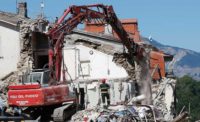Italian Quake Investigators: Reinforce Europe's Old Masonry




















U.K. investigators studying the April 6 earthquake that rocked Italy west of Rome, killing some 300 people, found that traditional stone masonry buildings with even basic strengthening survived the temblor. As a result of their findings, the engineers are calling for simple reinforcements of older masonry buildings throughout Europe.
"It was good to see, where there had been upgrades, the buildings performed better," says Tiziana Rossetto, who led 10 engineers and scientists from the U.K. Earthquake Engineering Field Investigation Team (EEFIT). With many homes in Europe and also the developing world sharing traditional building methods, "we need more willingness...to spend a bit of money on reinforcing these houses," she adds.
A structural engineer and university lecturer, Rossetto also heads the Earthquake and People Interaction Centre at University College, London. The volunteers she led included experts in seismic risk modeling, geophysical hazards earthquake engineering and others.
The EEFIT team spent six days surveying the devastated city of L'Aquila and its hilly surroundings, taking off from the U.K. nine days after the shock. With the earthquake's epicentre some 10 km away, L'Aquila was devastated. The 6.2 Mw (moment magnitude) shock occurred 8 to 9 km below ground, 95 km north east of Rome. L'Aquila had been largely destroyed by an earthquake in 1703.
Most of L'Aquila's buildings are two-to-four stories and made of two skins-stone masonry infilled with rubble. Many have been strengthened in various ways, including with the addition of wall ties and steel lintel beams.
A third of the buildings in the city center showed damage to load-bearing walls, with many suffering internal collapses. Reinforced concrete buildings, mostly erected after the introduction of seismic codes, "performed very well," says Rossetto. While much cladding and many infill panels failed, "the structural elements weren't affected at all," she adds.
Italy's first building code for reinforced concrete buildings was published in 1939 and underwent a series of subsequent updates. The concept of response spectra to the seismic design was introduced in 1974. The codes require all possible seismic, gravity and live load combinations, excluding wind, to be considered. Code revisions followed in 1986, 1996 and 2003, along with upgrades of accompanying seismic hazard maps.
Concrete buildings in and around L'Aquila are up to eight stories, typically with moment-resisting frames infilled with either hollow clay brick or concrete blocks. Three major failures seen by EEFIT had all suffered "soft-story failures" at ground floor level.
"Failure was precipitated by irregular stiffness in elevation. Poor detailing of reinforcement in connections was evident as well as lack of confinement in columns," notes EEFIT's recently published preliminary report.
A university students' residence, a five-floor apartment block and the Hotel Duca degli Abruzzi all collapsed. They were built in the 1970s, just after the seismic code's introduction.
Among weaknesses spotted by EEFIT was the inclusion of smooth rebar, which is no longer used, says Rossetto. Modern three-floor concrete buildings in nearby Paganica, with "good detailing," were almost unscathed.
The EEFIT team covered the devastated area, supported by emergency services, which functioned "very, very well," says Rossetto. Lodging in a coastal hotel, the team traveled to the earthquake zone 90 minutes away every day.
In the hotel, "we were able to interview displaced people," says Rossetto. And "we didn't want to be caught up in aftershocks [and] impede rescue and recovery," she adds.
"We go to large events when we think there is something new to learn," says Rossetto. She believes the L'Aquila disaster highlights the value of even modestly strengthening traditional masonry buildings, which abound in southern Europe.








